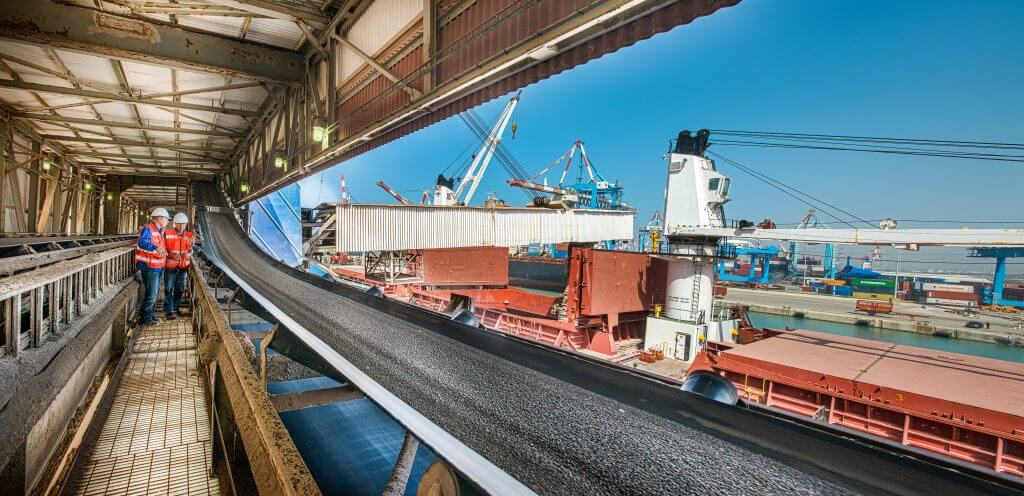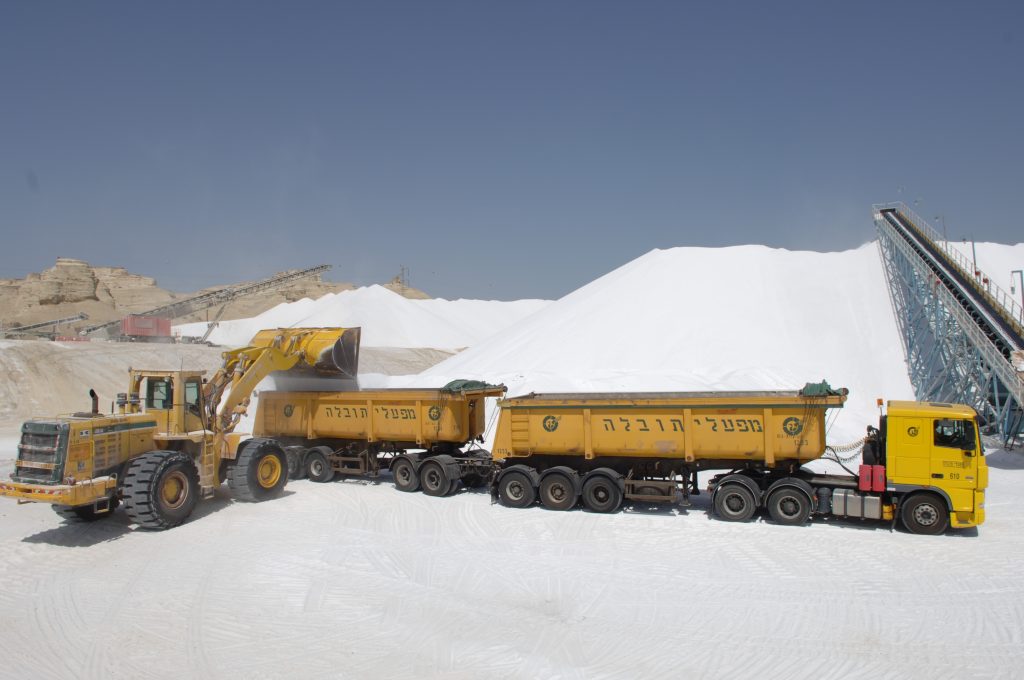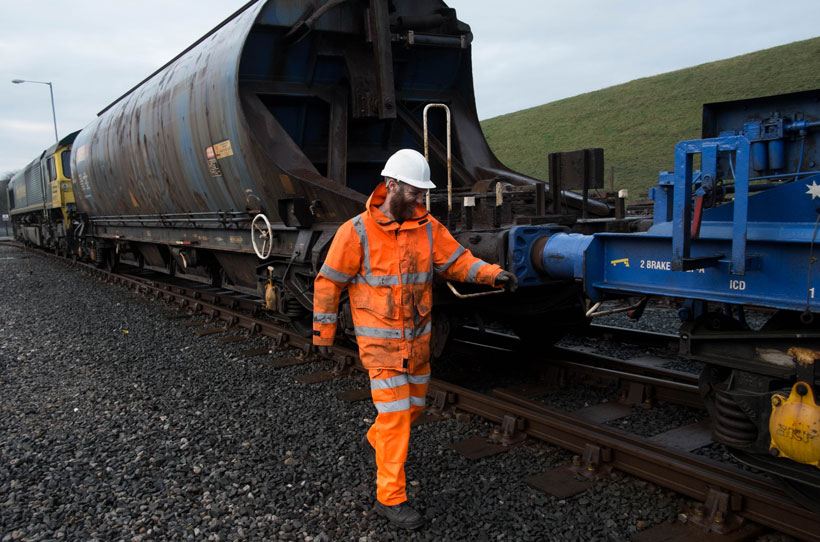Next Topic
Select SDGs to find out how we are taking action in support of the UN Substinable Development Goals
2023 ISRAEL CHEMICALS LTD. | ALL RIGHTS RESERVED

ICL benefits from the proximity of its facilities to developed economies as well as to emerging markets.

Most of ICL’s products in Israel, whether in solid or liquid state, are transported from the Company’s southern sites by rail to the Ashdod and Haifa ports or by trucks to the Eilat port. The port of Eilat is located in the far south of Israel on the Red Sea coast, approximately 180 kilometers south of Rotem and 200 kilometers south of Sdom. Shipments exiting the Eilat port are usually to the Far East, whereas sales to Europe and North and South America, as well as some sales to the Far East, are transported from the Ashdod port.

Potash from ICL Dead Sea is transported by a conveyor belt from the Sdom site to a railhead located at Tzefa in Mishor Rotem, and from there the output is transported by rail to Ashdod port.
A major part of truck transports of ICL products in Israel is handled by ICL’s wholly owned subsidiary, ICL Tovala, which operates rigid freight trucks and trailers.

Safety is a core value for ICL, including in logistics and transportation.
ICL uses multiple modes of transportation to transport its products and employees. As a result, transport by road is one of the issues on which ICL focuses its attention.
In Israel, ICL maintains driver safety rules that prohibit employees who receive repeated warnings/fines from driving Company vehicles.
ICL has also initiated a carpool pilot program that will give additional benefits to employees who ride together to work.
ICL is reviewing its logistics fleet, in order to increase its efficiency and minimize air pollution. The fleet is transitioning to advanced Euro 6 trucks, which use urea additives to reduce their emissions.
ICL Iberia transports by conveyor belt the excavated ore from the Cabanasses mine to the production plant. The final products potash and salt are transported from the plant to its customers by trucks and trains to the local market, and via railway to Barcelona port to the overseas markets. A designated railway line is used for the transport of potash from the mines to the Barcelona port. Most of ICL Iberia’s shipments are made via a terminal it owns at the port of Barcelona (Trafico de Mercancias – Tramer). ICL Iberia owns and maintains approximately 1.5 kilometers of standard gauge railway at Suria plant that connect to the regional rail network. Up to three trains leave on a daily basis with a total payload capacity of 800 tons, spread out over about 21 freight cars. During 2019, ICL Iberia signed, a new freight rail transport agreement with FGC (Ferrocarrils Generalitat de Catalunya), which is expected to increase the capacity of the rail transport. In 2022, it is expected to increase to 24 freight cars, 1,000 tons and up to seven daily trains. The rail route for potash transport from Suria to the terminal in the port of Barcelona includes a rail route of about 80 kilometers. The production site (Suria) has one rail load out system for the rail to port transport systems. The train traction engine and part of the bulk freight car rolling stock is operated by the owner and operator FGC (Ferrocarrils de la Generalitat de Catalunya).
ICL Iberia owns and operates its own port facilities, which consist of bulk potash and salt storage facilities, comprised of freight car and rail truck conveyor unloading facilities and product storage warehouses.
As part of the plan for increasing ICL Iberia’s production capacity, an upgrade is being made to the logistical infrastructure at the Suria Site and in the Cabanasses mine (entrance ramp into the mine, commissioned in 2021), the factories and the Company’s berth in the Barcelona port, in such a manner that will permit production, transport and export of about 2.3 million tons of potash and salt per year.
The new facilities at the port of Barcelona are managed by ICL Iberia’s subsidiary Tramer.
By increasing the number of freight convoys to the port, an initial reduction of about 86,000 vehicles per year by road with the corresponding decrease in CO₂ emissions is expected, as well as contributing to the increase in road safety.
Read More
ICL’s Boulby mine in the United Kingdom is connected by a network of roads running over 11 kilometers southward from the mine entrance, as well as a network of underground roads extending 17.5 kilometers from the mine entrance in the direction of the North Sea. Approximately 80 kilometers of underground tunnels remain open to support current production. The mine enjoys easy access to national road and train transportation routes.
Pursuant to agreements with the North Yorkshire National Parks Authority, the total transport movements by means of the network of roads from site to site are limited to a maximum of 150 thousand tonnes per year and a maximum of 66 road wagons per day (no road movements are allowed on Sundays or bank holidays).
The rail load-out products are transported on an ICL Boulby-owned rail line which extends approximately eight kilometers from the mine entrance to a junction with the national rail network, and from there the products continue to Teesport, Middlesbrough, via the Network Rail Company, the owner and operator of the main rail line.
Eight trains per day transport Polysulphate®, PotashpluS and rock‑salt to Teesdock. Most of the Polysulphate® output is used as a component in agricultural fertilizers, and volumes are exported by sea from the Teesdock seaport to customers in the UK and overseas.
Rock‑salt is transported by train to Teesdock and loaded onto ships or trucks to local UK authorities for de‑icing roads.
ICL Boulby leases and operates three principal storage and loading facilities: the Teesdock facility, which is located on the Tees River, and two additional storage facilities that are connected to the main rail line – Cobra and Ayrton Works in Middlesbrough.
The YPH JV includes the Haikou mine, several factories for production of various types of fertilizers located close to the Haikou mine, and two plants for production of downstream products – one located close to the Haikou mine and the fertilizers factory and the other situated near the Kunming airport.
Most of the transport of raw materials from the Haikou mine to the acid factories is executed via pipeline (slurry), whereas a small portion of the raw rock is transported by trucks.
Most of the output sold to the local market is transported from the fertilizers factory directly to customers in North China by train, as well as through marine shipment, mainly from two ports (QinZhou port and Fangchengang). A small portion of the output sold is transported to customers in the Yunnan region.
